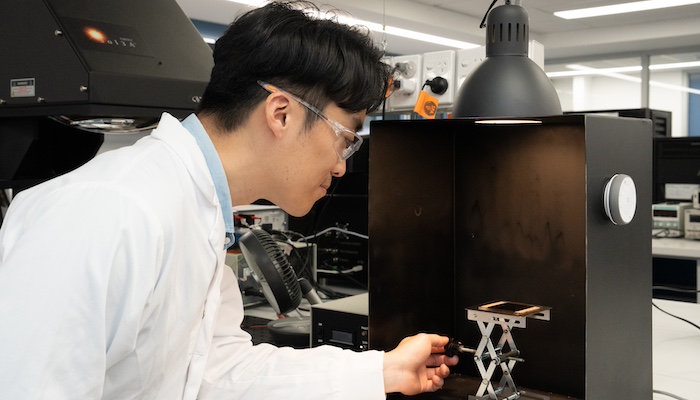Macquarie University researchers partnering with three Korean institutions have created an innovative solar cell to efficiently convert indoor light into electricity with record-setting performance.
15 June 2024
An Australian-Korean research team working with Macquarie University has developed a new solar cell that achieves record-breaking power conversion efficiencies in low-light indoor environments.
The breakthrough technology, published in the journal EcoMat (Wiley) on 29 May 2024, has two innovative components: it uses perovskite (instead of the traditional silicon) to generate electricity, and an aluminium layer to reduce energy leaks.
“Our technology paves the way for more efficient, self-sustaining Internet of Things (IoT) devices,” says Dr Jincheol Kim, Research Fellow at Macquarie University’s School of Engineering and the corresponding author for the research.
Co-author Professor Shujuan Huang is Director in Photovoltaics at the Sustainable Energy Research Centre (MQ SERC) at Macquarie University’s School of Engineering.
“This research marks a breakthrough in the amount of energy we can generate energy from indoor lighting using perovskite solar cells, opening up exciting possibilities for self-powered IoT devices and sensors for automation and monitoring in industrial settings and in smart homes.
“By efficiently harvesting indoor light, this technology can revolutionise the way we power electronics, reducing our reliance on disposable batteries and promoting a more sustainable future,” she says.
Perovskite advantage
Perovskite compounds are based on the mineral perovskite that occurs naturally in the Earth’s crust but are usually artificially synthesised in laboratories.
Perovskite materials are better at converting light into electricity than most other materials used in solar cells. They are also very good at absorbing visible light and efficiently converting it to energy.
Perovskite can be used to make lightweight solar cells using solution-based methods, such as spin coating or printing by dissolving chemicals in a liquid and reading it evenly over a surface. The liquid forms a thin, uniform layer of perovskite as it dries. This is a faster, cheaper and more flexible process than those used to make other solar cell technologies, which require expensive equipment and high temperatures.
Solar photovoltaic cells are made up of at least five layers. These include a transparent layer to allow sunlight to pass through, a light-absorbing layer (such as silicon or perovskite) to generate electrical charges, and extra layers to efficiently extract and transport these charges.
The research team has designed an additional layer, made up of porous aluminium inserted between other layers to reduce energy leakage thereby significantly improving the solar cell’s performance.
Leak challenge
Dr Kim says all solar cells face the challenge of ‘leaking’ electrical current because of internal and interface defects.
“Reducing leakage is particularly important for indoor light conditions because low light intensity generates less current, so every leak makes a difference,” says Dr Kim.
The research team has developed an innovative solution to this problem, which takes advantage of the multiple layers of material typically used in solar cell construction.
“By incorporating a porous insulating aluminium layer in between the perovskite and charge transport layers, we have been able to substantially reduce the amount of current leaking in the devices,” Dr Kim says.
“We have achieved record power conversion efficiencies for perovskite solar cells under indoor lighting conditions.”
An important measure of efficiency in solar cells is power density, meaning how much power can be generated in a given area, measured in milliwatts (one billionth of a watt) per square centimetre.
The team's optimised perovskite solar module with the aluminium interlayer achieved a remarkable power conversion efficiency of 33.5 per cent, and a record-breaking power density of 107.3 milliwatts per square centimetre under the typical light level in a well-lit office or living area.
This marks the highest power density ever reported for an indoor perovskite photovoltaic module.
By comparison, other commercialised solar cells have an efficiency of only nine to ten per cent in a standard indoor light environment.
“We have demonstrated a power density in our perovskite solar modules that is around three to five times greater than any commercially available photovoltaic cell that is currently available for indoor use,” says Dr Kim.

Real world demonstration
The researchers demonstrated the real-world viability of their solar module by successfully powering an LED lamp under standard indoor lighting conditions.
The achievement highlights the potential for this solar technology to be integrated into IoT sensors, smart devices and other low-power electronics.
“Our results show that there’s a bright future for perovskite solar cells in improving indoor energy harvesting performance,” said Dr Kim.
“This technology will enable self-powered, wireless IoT networks that will drive advancements in smart homes, smart buildings and industry 4.0."
The research was supported by the Australian Research Council and the Australia's Economic Accelerator Seed Grants and involved collaboration with Ajou University, Sungkyunkwan University and the Korea Research Institute of Chemical Technology.
Φ